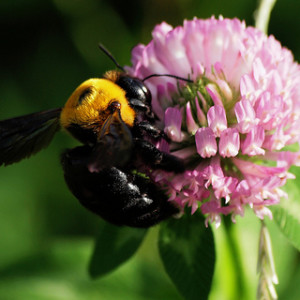Carpenter Bees Are Out and About!
By Chris Williams on April 14, 2015.

I was getting mail out of the mailbox yesterday when I saw that old familiar black and yellow bee buzzing at me in a threatening way. I wasn’t too worried though because I recognized the aggressor as a male carpenter bee and I knew his threat was all bluff.
How did I know it was a carpenter bee?
Carpenter bees are large (almost 1 inch), robust bees with a yellow, fuzzy thorax and a shiny black abdomen. If the black abdomen had also been fuzzy, that would mean a bumble bee, not a carpenter bee. I knew it was a male because he also had a yellow spot on his face, right between the eyes, a characteristic that only the male bee possesses.
Why wasn’t I worried?
Carpenter bees do not live in colonies like social bees. A single couple is responsible for creating and stocking the nest that is chewed into soft wood. It’s the job of the male carpenter bee to patrol the nest site and protect the female and the location from potential predators. He does a good job of buzzing and diving at people who move within his secured perimeter…but he can’t sting. Maybe he doesn’t know that. Only the female bee has a stinger, which is also an ovipositor for laying eggs. She’s capable of stinging, but she’s not aggressive and she is much too busy digging out her nest hole.
What was the bee doing at the mailbox?
Carpenter bees chew dime-sized, circular holes in soft woods. Inside, the female lays a series of eggs, and each egg is left with a pollen ball food supply. The bees look for weathered, soft wood that is not painted or varnished. Their favorite nest sites are the fascia boards (which are unpainted on the back side) around the roofline, deck railings, wooden deck furniture, shutters (back side), porch ceilings, and fence posts. Their favorite types of soft woods are redwood, cedar, cypress, Douglas fir, teak, and pine. Our street-side mailbox is mounted on a wooden post and cross bar. It’s pine, has been there at least 25 years, is unpainted, well-weathered, and a favorite nest site for carpenter bees.
How long will the bees be a nuisance?
Most of the time, carpenter bees don’t bother anyone, and unless they are nesting near each other, any damage is mainly cosmetic. They can, however, nest again each year in the same sites, and may be joined by other bee pairs that also like that nest location. In this case, there can be cumulative damage. Carpenter bees only have one generation a year. They appear in April to May, create a nest, provision the galleries, and then leave. The whole process takes little more than a week. The bee larvae in the nests quietly feed on pollen and emerge from the nest in late summer. During this time, woodpeckers can become a nuisance as they peck at the wood trying to reach the fat larvae that they know are inside. If carpenter bees or woodpeckers are driving you nuts this spring, give Colonial a call. For more on carpenter bees, check out these blogs: